|
1.
CENTRAL/ WEST AFRICA
Log markets remain steady
Central and West African log markets remain steady and the recent price
increases have been well absorbed in the markets without any disturbance to
the flow of business. Prices remain unchanged during the first weeks of
November and demand from the major markets is firm.
The European demand for tropical hardwood logs is still declining and
current stock levels are reportedly adequate to fulfil projected demand for
the winter period.
Sawnwood in good demand
West and Central African sawnwood prices are firm after the gains made in
October. Saw mills in the region expect good demand through the rest of the
year into 2011.
Generally prices have not changed from October. However, demand for padouk
is strong, pushing its price up by Euro10 per cu.m for FAS GMS to Euro570
per cu.m, while scantlings were up by Euro20 per cu.m to Euro585 per cu.m.
Iroko sawnood is in good demand for the European and Asian markets. However,
according to analysts, under the current high production volume there is a
risk of overstocking and eventual decline in prices.
Uncertainty clouds demand prospects in Europe
Projections of European demand for tropical timber in 2011 remain uncertain.
Housing starts in Europe are at low levels, but refurbishment activity has
picked up. Improved refurbishment and renovation activity is good news for
hardwoods as this sector uses more hardwoods and decorative timbers in
joinery, carpentry and finishing than structural timbers.
China has introduced policies which are expected to increase imports of
sawnwood rather than logs to China. If these policies are implemented within
the short to medium term, the West and Central African mills have the
capacity and resources to meet the greater sawnwood demand from China.
Projections for the rest of the year 2010 to the end of the first quarter of
2011 suggest that demand and supply will remain in balance and prices will
continue to be stable.
Promising market prospects in Asia for Central/West African timber
The economies in Asia and Middle East are strong. Both China and India in
particular are poised to meet forecast growth in demand for in-country wood
processing industry for both the domestic and export markets.
So far, these countries are procuring much less logs and sawnwood from West
and Central Africa than from the Asia-Pacific region. However, producing
countries in the Asia-Pacific region are pushing their industries to produce
more processed products, leaving less logs for export. This could create
more opportunities for African exporters to tap these markets, as producers
in Asia and Middle East are still demanding logs and sawnwood, because of
their low labour and processing costs, say an analyst.
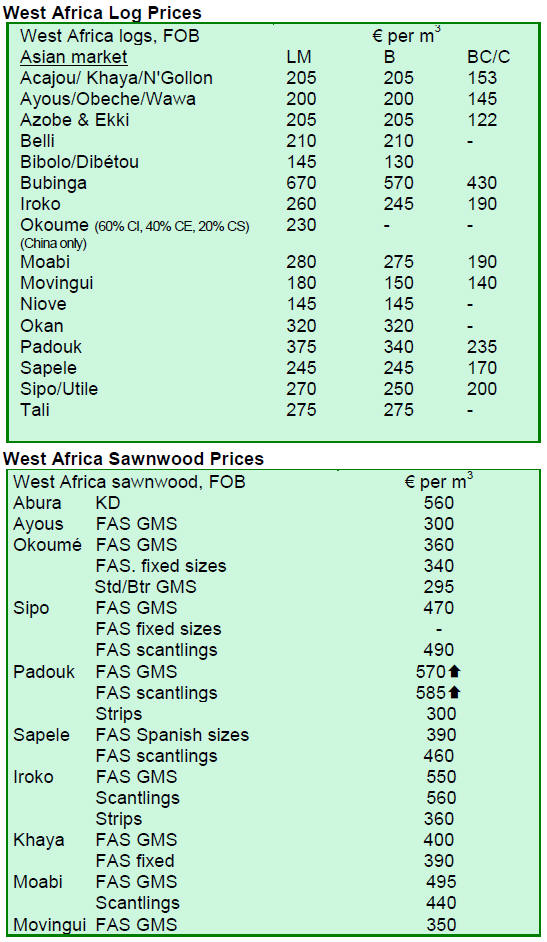
¡¡
2. GHANA
Forestry Commission to promote legal timber for domestic market
The Forestry Commission of Ghana is working together with Tropenbos
International to develop policy recommendations for enhancing production and
trade in legally harvested timber for the domestic market.
The initiative is in line with the Forest Sector Development and Strategic
Plan of the Forestry Commission. The Strategic Plan places emphasis on an
efficient forest industry and value-added production among others.
The overall objective is to create an enabling environment for an efficient
forest industry, by ensuring sufficient supply of legally harvested timber
in the domestic market and discouraging illegal timber trade. Once the
recommendations are completed, these will be submitted to the Ministry of
Lands and Forestry for consideration.
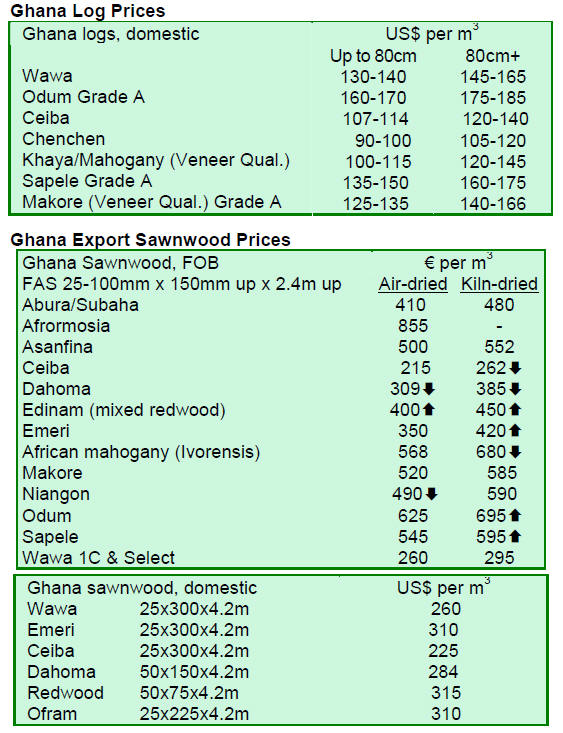
¡¡
3.
MALAYSIA
Monsoon and dam impoundment lead to drastic fall in log supply
Buyers of logs from Sarawak are facing a drastic shortfall in log supply,
which has also resulted in higher log prices. One of the main reasons for
the tight supply situation is the early monsoon season which affected log
harvests.
The other reason for the log shortage could be the impoundment of the Bakun
hydroelectric dam that might have lowered the level of the Rejang River and
its tributaries which have been used to transport logs from the major
logging areas in Sarawak. As a result, the transport of logs for processing
mills and exports has been disrupted.
The other option for logging companies is to transport logs overland by
lorries. However, this option will cost an extra US$10 to US$15 per cu.m
vis-¨¤-vis river transportation.
The tight log supply has an impact especially on the Indian market, which is
the biggest for logs from Sarawak. For the first seven months of 2010,
exports to India accounted for 1.3 million cu.m of the total of 2.4 million
cu.m of log exports from Sarawak.
Increasing production of environmentally friendly plywood
The largest plywood manufacturer in Malaysia, Shing Yang plywood group, has
a monthly production capacity of 100,000 cu.m comprising four plants.
Current production volume is only around 70,000 cu.m per month, out of which
50-55% is shipped to Japan. Other destinations are Republic of Korea, the
US, Taiwan P.o.C, the Middle East and neighbouring South East Asian
countries. The reasons for the current production include a shortage of raw
material and volatile consumer markets, reports the Japanese Lumber Reports
(JLR).
According to JLR, the company is increasing production of the so-called
e-panels which are environmentally friendly plywood products made of
plantation wood. The main products are flooring base board, concrete
formboard, structural and standard panels, and LVL (Laminated Veneer
Lumber).
The company owns 650,000 hectares of land, out of which 350,000 hectares are
forest plantations. Shing Yang group has developed the first plantation area
in 2000 and it is planting 40 million trees every year to keep production
sustainable. The plantations include about 40 different species which are
tested by the company to identify appropriate end-uses.
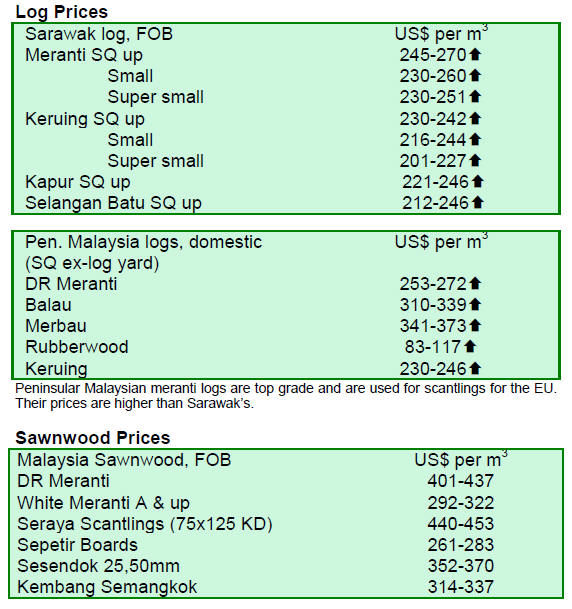

4.
INDONESIA
President Obama addresses climate change and
deforestation during visit
On 10 November 2010, the US president Barack Obama visited Indonesia. During
his visit, he addressed the issues of climate change and deforestation in
discussions with the Indonesian government. This effort is seen as another
development to advance diplomatic relationships and trade between these two
countries.
He was expected to announce how some of the US$700 million grant allocated
to Indonesia by the Millennium Challenge Corporation (MCC), a US foreign aid
agency set up under the former Bush administration, could be used to finance
climate change and forest conservation programmes in Indonesia to create
tradable forest carbon offsets that would help the US industries to meet
future emission reduction targets.
In addition, he would unveil details of the implementation of four-year
programme on addressing deforestation, reducing loss of biodiversity and
improving the land use management. This programme involving US$35 ¨C US$40
million was announced earlier this year.
The US has also pledged US$20 million for marine conservation and promotion
of clean-energy development in Indonesia.
Indonesian furniture sector falls short of export target
The Association of Indonesian Furniture and Handicraft Industry (Asmindo)
stated that its recent marketing efforts to boost sales had fallen short of
its target. During the period from January to October 2010, only half of the
targeted growth of 30% over the previous year was achieved. Sales amounted
only to US$25 million during the period.
Asmindo calls for a more effective marketing programme for Indonesian
furniture, which would also help to generate more jobs in the country.
Rubberwood and construction material prices soar
The heavy monsoon and flooding in Thailand extracted a heavy toll on the
main rubber tree plantation areas in Thailand, thereby lifting rubberwood
prices across the South East Asia. Thailand is the world¡¯s largest
rubberwood and natural rubber producer.
In addition, the devastation and evacuations arising from the violent
volcanic eruptions of Mt. Merapi near Yogyakarta, has resulted in soaring
construction material prices in Indonesia. The tragic volcanic eruptions,
which have destroyed homes, farms and killed livestock, have also displaced
more than 100,000 Indonesians to date.
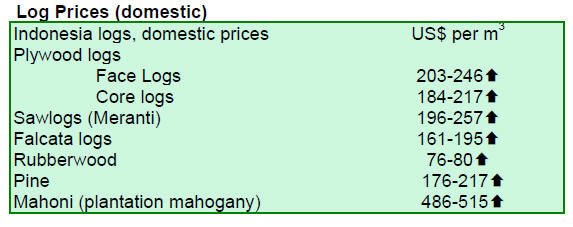
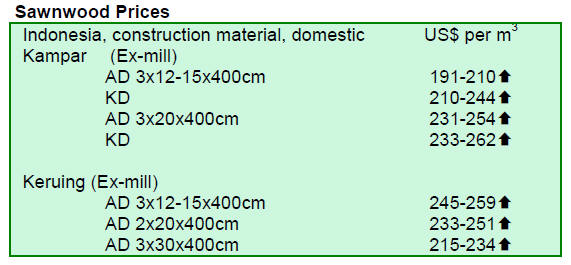
5.
MYANMAR
Teak market remains brisk in India
The market situation remains unchanged over the previous month. Apart from
India, other markets are quiet. It has been reported that the teak market is
good in India especially for grade 7 logs and good quality pyinkadoe logs,
while demand for Gurjan logs is sluggish.
Monthly shipments of teak and other hardwoods for the past three months
indicate the current market situation. Teak shipments were reportedly around
22,000 Hoppus tons in August, 15,000 Hoppus tons in September, and 22,000
Hoppus tons in October. The average export volume for other hardwoods was
70,000 Hoppus tons per month.
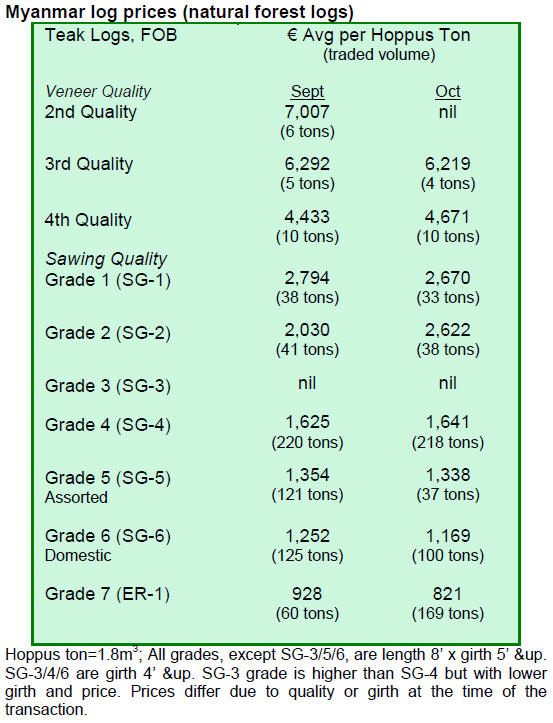
¡¡
6. INDIA
Sharp jump in exports helps trim down
trade deficit
According to the Department of Commerce India, exports in September were
US$18 billion, up 23% compared to September 2009. The result was the highest
in 24 months. September imports in India grew 26% to US$27 billion compared
to last year. As a result, the trade deficit in September decreased to
US$9.1 billion from $13 billion recorded in August.
The Indian economy is forecast to grow by 8.5% - 9.7% in the fiscal
2010-2011. The main driver for the economic growth is domestic demand,
according to the Ministry of Finance India. In addition, IMF revised the
forecast for Indian economic growth to 9.7% in 2010 and this is expected to
encourage more foreign investments in the Indian equity markets.
India¡¯s forest cover expands by 3 million hectares
India¡¯s forest cover expanded 3 million hectares over the last 10 year,
according to the Environment and Forest Ministry India. India is planning to
launch satellites in 2013 to monitor the country¡¯s forest cover.
International Panelexpo and Conference 2010 postponed
The organisers of Panelexpo 2010 have announced that due to the distracting
news circulated during the Commonwealth Games and the festival season in
India, many of the participants had called for the postponement of the fair.
The fair was planned for 1-4 December 2010 at NSIC Exhibition Ground Okhla,
New Delhi and the new dates will be announced in due course.
Furniture fair showcases alternatives to plywood
The Index International Furniture Fair 2010 held between 8 ¨C 11 October in
Mumbai showcased a number of alternatives to plywood for interior
decoration. For example, advanced digital printing techniques have brought
paper laminates to the markets. The fair also signalled that composite
flooring panels as well as printed and coated Medium / High Density
Fibreboards are gaining ground in markets with expanding production
capacities against plywood.
India delegation participates in US furniture fair
The International Woodworking Machinery & Furniture Supply Fair was held
from 25 to 28 August in Atlanta USA. The India delegation was led by CAPEXIL
(Chemical and Allied Export Promotion Council of India) and included wood
and timber product importers and exporters. The visit has resulted in new
business and trade contacts for the delegation, reports CAPEXIL.
Strong demand for plantation teak
According to an analyst, there is a substantial flow of plantation teak to
India and demand from the housing sector is expected to pick up as the
monsoon season is over. Recently, some lower grades have arrived at cheaper
prices than standard grades. These are included in the price table below.
Plywood manufacturers face shortage of peeling grade logs
Shortage of peeling grade logs is plaguing the plywood manufacturers.
Eucalyptus and poplar logs are used to keep the mills running. The
manufacturers are also still suffering from shortages of labour and power.
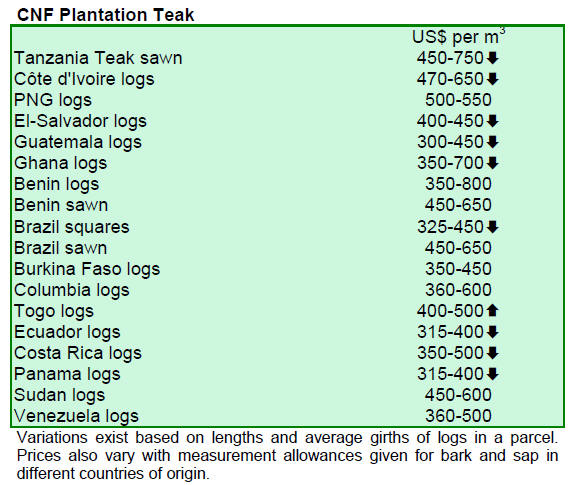
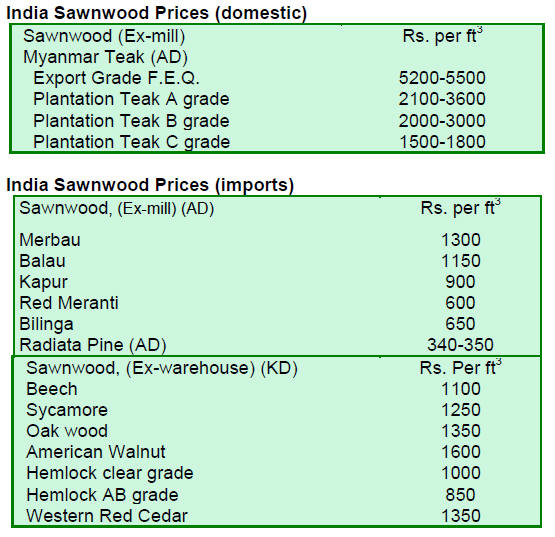
7. BRAZIL
Forest sector is key to economy in Par¨¢
According to the report ¡°Price of standing timber, Economic Value and Timber
Market in Transition Contracts in State of Par¨¢¡±, published by the Para
Forestry Institute (IDEFLOR), the forest sector plays a kea role in the
economy of Par¨¢ state, generating jobs, income and foreign exchange.
In 2008, the forest sector¡¯s revenues reached US$4.46 billion accounting for
9.6% of the state¡¯s GDP and generating 30,481 jobs, representing 3.6% of the
total employment in Par¨¢. According to the report, although timber trade in
Par¨¢ state involves low value-added products, Par¨¢ remains a net exporter of
timber products, with a total surplus of R$1.93 billion (R$2.37 billion of
exports and R$0.44 billion of imports).
The report notes that as the forest sector generates significant income and
employment in the state, it is therefore a strategic sector in the context
of rural development in the Amazon.
Available area for concessions in Brazilian Amazon exceeds 1 million
hectares
The area available for forest concessions in the Brazilian Amazon has
exceeded 1 million hectares, according to the Brazilian Forest Service (SFB).
The total area consists of seven concessions in the states of Rondonia and
Par¨¢. The estimated timber production in the total concession area is
850,000 cu.m per year.
According to the SFB, forest concessions have been promoting the
implementation of sustainable forest management, generating jobs, improving
living conditions of forest dependent people and conserving natural forests.
For the private business, concessions offer an opportunity to have legal
access to forest resources in the long-term.
The forest concession contract value for the Jamari National Forests and the
Sarac¨¢-Taquera National Forests totalled R$6 million. The amount collected
from other concessions will be known after the bidding process is completed,
as companies may pay premium over the minimum price set by the SFB. The
minimum total value of the concessions under the bidding process is over
R$20 million a year.
The SFB estimates that forest concessions practising sustainable forest
management have the potential of increasing timber output in the future.
Timber product exports on course for growth in 2010
Analysts say that if the current economic trend continues without any
downturn, timber exports from Brazil will record a growth in 2010.
From January to September 2010, export value has gained 11% compared to the
same period in 2009. The segments that contributed the most to this growth
are veneer and mouldings, increasing 35% and 16% compared to the same period
last year respectively.
For tropical hardwood sawnwood, a 4% growth in export volume was recorded
from January to September 2010 compared to the same period in 2009, up from
380,731 cu.m to 396,145 cu.m. In value terms, the growth was 6.3%, from
US$179 million from January-September of 2009 to US$191 million in 2010. The
exports of sawnwood in September 2010 topped US$24 million, equivalent to
51,267 cu.m of hardwood sawnwood.
Furniture exports from Rio Grande do Sul show signs of recovery
Wooden furniture exports from Brazil have been declining since the economic
crisis started in 2008. However, at the end of 2009, exports started to show
some signs of recovery. According to the Association of Furniture Industry
of Rio Grande do Sul (Movergs), furniture exports from Rio Grande do Sul in
2008 amounted to US$289 million, accounting for 30% of total furniture
exports in the country.
In 2009, furniture exports from Brazil totalled US$707 million. In Rio
Grande do Sul, the leading furniture cluster in the country, exports reached
US$200 million, accounting for 28% of the national total.
Furniture exports in the country from January to September 2010 amounted to
US$573 million, up 13% compared to the same period in 2009.
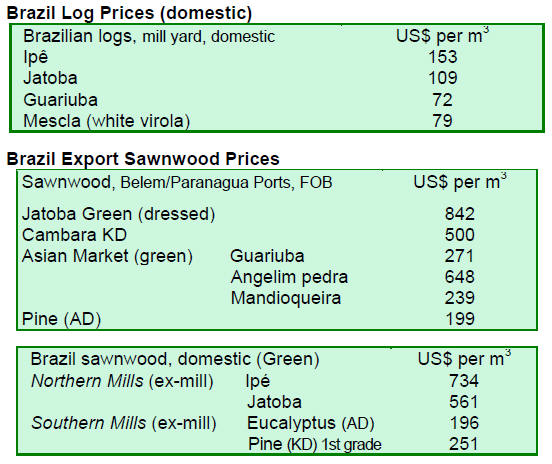
8.
PERU
Peru timber exports poised for strong growth
Wood and timber product exports are forecast to grow by 20% - 30% in 2010
over the previous year to US$200 million, according to the National
Exporters Association (ADEX).
In 2009, wood and timber product exports from Peru were valued at US$157
million, while in 2008 exports totalled US$219 million.
From January to August 2010, wood and timber product exports rose by 30% in
value compared to the same period in 2009. Semi-manufactured products such
as sawnwood and wooden flooring contributed to export growth during the
period. These products were mainly exported to the US and China.
The forest sector in Peru generates more than 500,000 jobs and this is
expected to increase by 80,000 by the end of the year.
Granting of new concession areas delegated to regional governments
There are seven million hectares of forest concessions in Peru which are
monitored and regulated by the State to ensure the sustainable development
of forestry and domestic investments into the forest sector.
Forest concessions used to be granted by the Ministry of Agriculture¡¯s
department of Forestry and Wildlife. Currently, the regional governments,
such as Loreto, Ucayali, San Mart¨ªn, have the power to grant concessions
after evaluation made by the department of Forestry and Wildlife. However,
since the transfer of power to the regional governments made in mid 2008, no
new forest concession areas have been approved, according to the Agency for
Supervision of Forest Resources and Wildlife (OSINFOR).
OSINFOR is the designated organisation monitoring and regulating forest
concessions in Peru. It has granted altogether 682 permits and
authorizations to operate in forest concessions during the last and this
year. Currently, there are 1,500 operators holding permits for forest
activities in concession areas and all of them are required to have annual
management plans.

¡¡
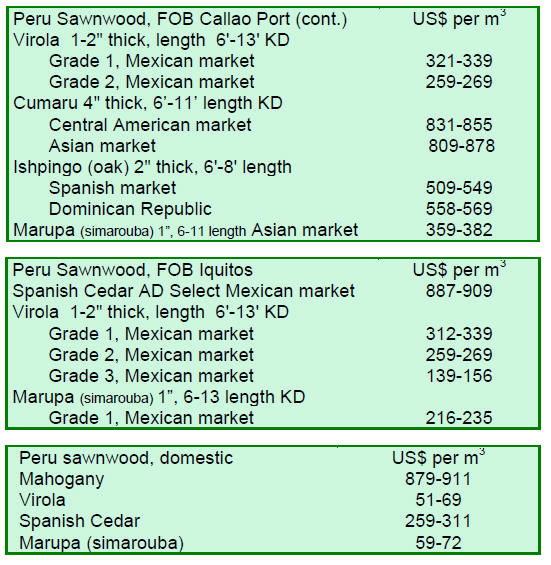
9. GUYANA
Timber exports and prices remain favourable
During the period under review, there were no exports of greenheart logs.
However, purpleheart logs were in demand attracting higher average prices in
both fair and small sawmill qualities. Similarly, mora log prices increased
for all qualities.
For sawnwood, prices gained in the period under review. Undressed greenheart
prices remained stable while undressed purpleheart (select) prices jumped
from US$750 per cu.m to US$1,350 per cu.m. However, the exported volumes
were small. Dressed greenheart and purpleheart prices gained while undressed
purpleheart prices remained unchanged.
Several Lesser Used Species (LUS) including burada, cow-wood, darina, fukadi,
iteballi, itikiboroballi, muniridan and Tonka bean were exported as sawnwood
during the period under review. The major markets for LUS were Asia,
Caribbean, Europe and North America. In addition, roundwood, fuelwood and
splitwood contributed to the total export earnings. Piles fetched a good
price average of US$831 per cu.m, with the major destination being the US.
For the period under review, exports of value-added products rose. The major
exported products were doors, indoor and outdoor furniture and windows.
Species used in furniture manufacturing included Crabwood (Andiroba),
Kabukalli (Cupiuba), Locust (Courbaril) and Purpleheart (Amarante). These
products were exported to the Caribbean and UK markets.
Capacity building to meet EU FLEGT requirements
On 10 November 2010, the Food and Agriculture Organization of the United
Nations (FAO) and the Forest Products Association of Guyana (FPA) signed a
Letter of agreement in support of a project entitled ¡°Building Capacity
within the Guyanese forestry sector to meet European Union¡¯s Forest Law
Enforcement Governance and Trade (FLEGT) Due Diligence requirements.¡± This
US$102,400 project will be funded by the European Union (EU) and implemented
by FAO.

¡¡

Related News:
|